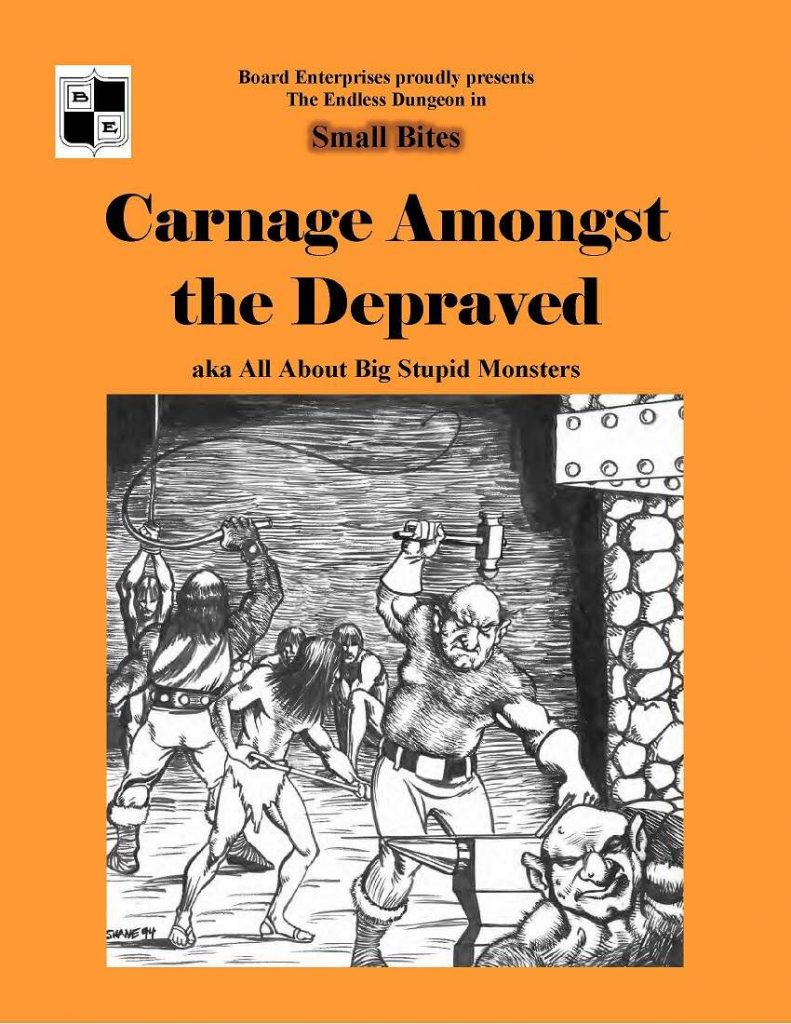
By John Josten Board Enterprises OSR/Legend Quest/die-20 Level 6
There are trolls, close to the city. Why? What are their plans? And when will they choose to start acting directly against the humans and elves who live in the region? Perhaps the best question might be will the party be able to do something about it? In this adventure, that is the challenge – Can they find a way to beat the trolls, because simply facing them sword to sword is not going to work against soldiers this fierce.
This sixty page adventure uses fourteen pages to describe a 23 room hack of ogres and trolls. It’s MASSIVELY overwritten, with everything pebble having a backstory and justification for it being there. Fuck me, the 90’s were a bad time for adventures.
Yes, the 90’s. This is some reprint of an adventure for a 90’s heartbreaker system. There seem to be a dozen or more adventures in it, so they kept at it. And continue to, it still seems to be alive today. Be it that 90’s style at the time or the same traits that lead to developing your own game system “that makes sense”, this thing shows all the hallmarks of over investiture.
Sixty pages, of which only fourteen are actually the dungeon. That means a lot of backstory, a lot of history, a lot of appendices, and a lot of telling the DM how the game should be played. We get to hear all about how to play dumb characters and creatures. Then the adventure proper shows up, a simple hack rescue. The first encounter is a page and a half, a lot take a column and a few empty rooms get only a paragraph or two.
Everything … EVERYTHING gets a fucking backstory. Nothing can be simple. Everything has to be padded out. The opening room, a simple guardpost, gets EIGHT paragraphs. There’s a troll and ogre behind a cracked door. The troll is eating some mutton and the ogre is unconscious, having been beaten by the troll. Eight fucking paragrapghs to describe that. And how can this be? Is it the Kwisatz Haderach? No. Here’s just one of those eight paragraphs: “The trolls do not consider the dwarven fortress to be of any value and do not think of it as an entrance. This is not so much a room as an intersection of hallways. Many of the trolls like this assignment because they feel there is nothing to do but sit. The area is lit by a single torch set in a brace on the wall.”
This is my life. Long italics read-aloud. Wall of text DM text full of meaningless backstory. “Strange and disgusting scents”, full of abstracted descriptions. Room descriptions that make you fight them just to understand how many creatures are in a room. All for a simple hack in a dungeon full of ogres and trolls.
The opening recruitment section does have some bolded sections to help the DM when King Whoever’s agent is responding to the party’s questions. That’s good. It recognizes that the DM needs to be able to find and reference information quickly. The bolding calls attention to this, offsetting it when scanned, so you can find it quickly. And that care is absolutely NOT taken in one other place during the actual adventure.
It’s unrunnable.
This is $5 at DriveThru. The preview is eight pages and only shows a few f the essays and background up front. Nothing of the encounters. Bad bad bad preview.
This has been episode “It’s too cold this morning for a bike ride and the liquor stone dont open for another hour.” of Bryce reviews everything on his DriveThru wishlist.
BONUS FEATURE! – Building Adventures
This is about a hundred digest pages on how to write an adventure. It follows the basic plot-based 3-act structure that overwhelmingly dominates these days. As a basic introduction to that it’s not bad. The purpose of the villain in the opening act is to X. The purpose of the villain in the middle act is to Y. The purpose of the villain in the ending act is to Z. It covers the basic structure of an adventure, from introductions, beginning the adventure, and a VERY basic adventure outline structure, ensuring the budding writer includes those elements that we’ve all come to expect, like a background/introduction.
You might think of it as the 3-act structure focused on D&D play. As such it’s ok. Too wordy for what it is, and you could probably do better getting a really good 3-act book. Besides, after two thousand reviews the problems with adventure is not that they use a 3-act structure or that they fail to make the 3-acts compelling.

I could feel the heat coming off this one soon as I clicked.
Re: Three-Act Play. I’d be willing to read an article of blog post length on it, if it were tailored for doing so in an OSR campaign.
96 pages? No way. I’ll remain ignorant.
Bryce’s affiliate link: https://www.drivethrurpg.com/product/318135/Building-Adventures?1892600